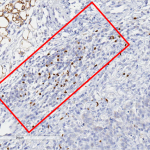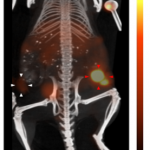 Immunotherapy
ImmunotherapyA major current focus of our laboratory is the development of strategies to combine immune adjuvants and thermal or chemotherapy. We find that such strategies can create a curative systemic response in aggressive cancers and we are working to characterize the mechanisms and enhance the efficacy. We are currently evaluating these strategies in pre-clinical models of breast and pancreatic cancer. We find that the immunosuppressive components of cancers (such as the T-regulatory cells shown on the left) can be diminished with an effective protocol.
 Molecular Imaging
Molecular ImagingMolecular imaging is a highly interdisciplinary research field, involving scientists from the biological, engineering, physical and medical sciences. Our laboratory explores the use of ultrasound, PET and MRI-based techniques to diagnose disease and to develop therapeutic strategies. One focus of the laboratory is to develop microbubble contrast agents for ultrasound molecular imaging. A second focus is to label drug and gene carriers and use positron emission tomography to quantify the pharmacokinetics. We have synthesized conjugates containing lipids, polymers and a copper chelator. As shown in the attached images, when the conjugate is injected without incorporation in a particle, the molecule ...
 Real-time Ultrasound Thermometry
Real-time Ultrasound ThermometryUltrasound imaging can spatially map small temperature changes resulting from hyperthermia. In our laboratory we release drugs from vehicles using mild hyperthermia. We have developed temperature-sensitive nanoparticles in which a drug is sequestered in a crystal at neutral pH and encapsulated in a lipid shell with a low melting point. After temperature-mediated release, the crystal is dissolved in a tumor or lysosome. By combining these particles with ultrasound, a large fraction of drug is delivered into tumors without systemic toxicity and we are achieving a complete response in local disease in a protocol that is not possible with existing agents. ...
 MR-guided Focused Ultrasound Therapy (MRgFUS)
MR-guided Focused Ultrasound Therapy (MRgFUS)Our laboratory has collaborated with Image Guided Therapy to develop preclinical MR-guided focused ultrasound technologies. Using a 3 MHz annular array, Bruker 7T MRI and motorized positioning system, we have developed methods to treat cancer by combining ultrasound with chemo and immunotherapy. We are now developing a 256 element MR-guided FUS system for integration with a clinical MRI in the context of interventional radiology. Our interests include the development of imaging techniques to guide and monitor the therapy and the use of imaging methods to assess efficacy. Shown on the left is thermal therapy of pre-clinical pancreatic cancer.
 Translational Cardiovascular Nanomedicine
Translational Cardiovascular NanomedicineWe are creating nanotechnology solutions for cardiovascular disease. Our lab is developing nanoparticles to image and deliver miRNA therapeutics to atherosclerotic plaque and damaged heart tissue. We are creating VCAM-1 targeted nanotherapeutics and have demonstrated the ability to prevent the development of atherosclerosis in mouse models as shown on the left. A current focus of the laboratory is the analysis of native vesicles and the development of nanotherapeutics that mimic structures that are efficiently internalized. In collaboration with the Searles laboratory we are evaluating whether the components of microvesicle membranes can be employed to improve engineered vesicles.
 Image-Guided Drug Delivery in Cancer
Image-Guided Drug Delivery in CancerThe central focus of our laboratory is image-guided drug delivery, combining nanovehicles, imaging techniques and methods to enhance delivery. A great challenge in cancer therapy is to deliver efficacious doses of drug to diseased tissue with minimal systemic toxicity. Another challenge is in the development of high-quality imaging protocols for identification of cancerous lesions as well as visualization of drug circulation and accumulation. We approach these problems through image-guided therapy strategies that include multiple imaging modalities (PET, CT, Ultrasound), delivery vehicle designs, targeting approaches, and release mechanisms. By encapsulating cancer therapeutics in particles designed to be stable in circulation and ...
